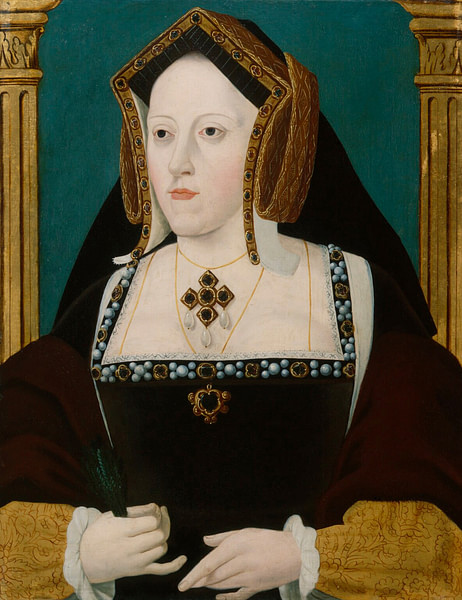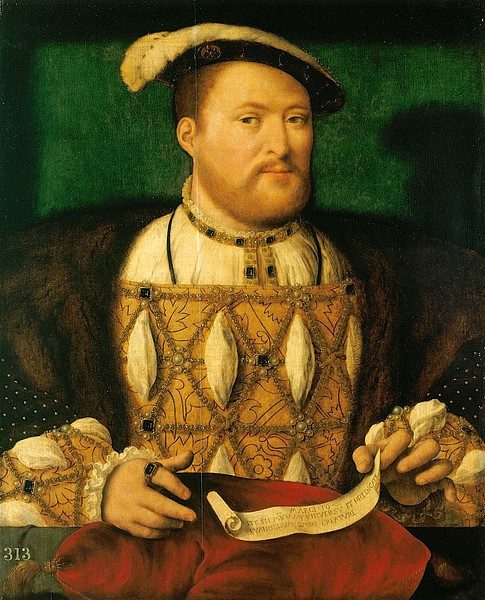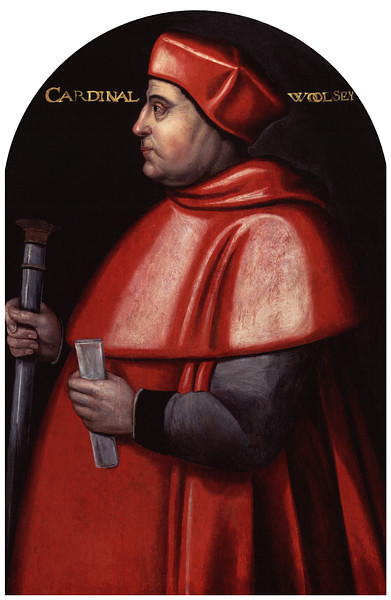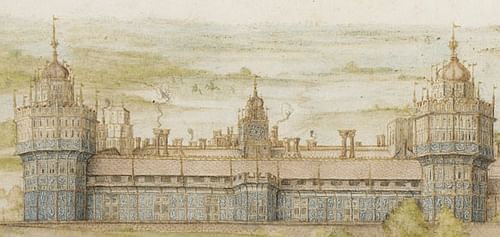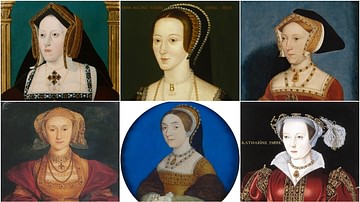
Henry VIII of England ruled as king from 1509 to 1547. The second Tudor king after his father Henry VII of England (r. 1485-1509), Henry had inherited a kingdom which enjoyed both unity and sound finances. Famous for his six wives as he searched for a male heir, the king was charismatic and domineering. In order to escape his first marriage, Henry set himself against the Pope and so began the Reformation of the Church in England whereby it broke away from Rome and the English monarch became its supreme head. A larger-than-life figure, Henry centralised government, further absorbed Wales into his kingdom, saw to the Dissolution of the Monasteries, formed the Royal Navy and built magnificent palaces such as St. James' in London. When Henry died, though, in 1547, he was succeeded by his juvenile son Edward VI of England (r. 1547-1553) and he left him an impoverished kingdom split over religious issues.
Henry Tudor
Henry Tudor had defeated and killed Richard III of England (r. 1483-1485) at the Battle of Bosworth in August 1485 in the last major action of England's dynastic dispute known as the Wars of the Roses (1455-1487). The House of Lancaster had finally defeated the House of York but Henry, crowned Henry VII of England in October 1485, was intent on creating a brand new ruling house: the Tudors. Henry married Elizabeth of York (b. 1466), daughter of Edward IV of England (r. 1461-70 & 1471-83), on 18 January 1486 and he even combined the livery badges of York and Lancaster to create a new royal symbol: the Tudor Rose. England was about to enter the post-medieval era with a new look and a new type of monarchy.
Early Life
Henry VII had seen off a few final challenges to his rule and set about filling the state coffers as much as he could, strengthening the crown and weakening the nobility in the process. The king's eldest son was Arthur (b. 1486) and he had married the Spanish princess Catherine of Aragon, daughter of King Ferdinand II, in 1501. Unfortunately, Arthur died the next year aged just 15. The king's next eldest son, Henry, born on 28 June 1491 at Greenwich Palace, became the heir to the throne and in 1503 he was made the Prince of Wales. Henry VII was keen to maintain friendly relations with Spain and so Prince Henry, after special permission was gained from the Pope, was betrothed to Catherine of Aragon. When Henry VII died of illness on 21 April 1509, Prince Henry became king. As arranged, he married Catherine on 11 June and was crowned Henry VIII in Westminster Abbey on 24 June 1509.
Contrary to the later and more famous portraits of Henry VIII, in his youth the king cut an athletic figure and, 1.9 metres (6 ft 3 in) tall with red hair and beard, an imposing one. Not for nothing was he a champion of the medieval tournaments his father had loved to organise. The prince was also a fine archer, horseman and tennis player, and when he was at rest he composed poetry and music and brushed up on his impressive knowledge of theology. In short, Henry was an intelligent and charismatic character who charmed all he met. The historian John Miller gives the following summary of Henry's powerful but changing character:
[Henry was] strong-willed, shrewd, capable of being moved to fits of generosity and enthusiasm, but also to savage anger. As a young man he was determined to enjoy being King and to outshine his contemporaries. As he passed his prime he became suspicious, capricious, devious and sometimes cruel.
(96)
The Six Wives of Henry VIII
Henry, perpetually in search of a male heir, went through an incredible six wives. These, and the children they bore, were:
- Catherine of Aragon (m. June 1509) - Mary (b. Feb. 1516)
- Anne Boleyn (m. Jan. 1533) - Elizabeth (b. Sep. 1533)
- Jane Seymour (m. May 1536) - Edward (b. Oct. 1537)
- Anne of Cleves (m. Jan. 1540)
- Catherine Howard (m. July 1540)
- Catherine Parr (m. July 1543)
The English king's first marriage to Catherine of Aragon produced six children but all except one died in infancy. The sole survivor was Mary, born on 18 February 1516. Henry had an illegitimate son, Henry Fitzroy, Duke of Richmond (b. 1519), with a mistress, one Elizabeth Blount but that was not much use to a king who craved a recognised heir. The king began looking for a new wife and he found his ideal candidate in Anne Boleyn, younger sister of one of the king's former conquests. Anne insisted on marrying the king before any thoughts could be entertained of raising a family. Henry's problem, then, was how to relieve himself of Catherine, an issue known as the king's 'great matter'.
The solution seemed to be a letter to the Pope suggesting that the lack of a male heir was God's punishment for Henry marrying the wife of his late brother, a point supported by the Old Testament (the 'Prohibition of Leviticus', Leviticus ch. 20 v. 21). Consequently, the king wished for the Pope to annul the marriage. Unfortunately for Henry, Pope Clement VII (r. 1523-1534) was keen to keep good favour with the most powerful ruler in Europe at the time, Emperor of the Holy Roman Empire, Charles V of Spain (r. 1519-1556), who was, significantly, the nephew of Catherine. Further, it was unlikely that Catherine and Arthur, being so young at the time, had ever slept together and so the 'Prohibition of Leviticus' did not in this case apply. The Pope at least sent Cardinal Lorenzo Campeggio to England to investigate the matter and preside over a special court in June 1529. Here both Catherine, determined to stay queen, and Henry, determined to get himself a new queen, presented their respective cases.
Despite Campeggio's efforts, nothing was resolved. Henry's next tactic was to permanently separate Catherine from her daughter Mary and shift her about the country to various dilapidated residences. Meanwhile, Henry and Anne Boleyn lived together (but did not sleep together). Sometime in December 1532, Anne, perhaps seeing a baby as the best way to rid herself of her rival Catherine, did sleep with the king and became pregnant. There would be serious repercussions regarding the Church but eventually, Henry had his marriage annulled the next year (see below). Catherine died of cancer in January 1536.
With Anne Boleyn, often known as 'Anne of a thousand days' for her brief reign as queen of the king's heart, Henry had a second daughter, Elizabeth, born on 7 September 1533. However, when the king discovered that Anne had had an affair and his eye had been caught by his next wife, he ordered her execution. The charge, and others ranging from incest to witchcraft, were trumped up because Anne had not produced a healthy male sibling to accompany Elizabeth and the king had tired of their turbulent relationship. Anne was found guilty and executed at the Tower of London in May 1536. A few weeks later Henry married his third wife, Jane Seymour, a lady-in-waiting at court, and she finally gave the king a son, Edward, born on 12 October 1537. The long-awaited arrival of a male heir sparked off gun salutes, bell-ringing and banquets across England. Tragically, Jane died shortly after and Henry genuinely mourned her passing; of all his wives it is significant that this was the one he wished to be buried alongside.
Anne of Cleves (daughter of the Duke of the German Duchy of that name) was wife number four but she displeased the English king - he had been misled by an overly flattering portrait of her by Hans Holbein the Younger before they had met in person. Henry married her anyway but, rudely calling her the 'Flanders mare', changed his mind a few months later and they divorced by mutual consent on 9 July 1540. Anne was relieved to escape with her life but Henry gave her a generous allowance, enough to live the high life until her death in 1557.
Wife number five was Catherine Howard, then only a teenager and another lady-in-waiting at court that had caught the king's eye. Catherine suffered the same fate as Anne Boleyn when she, too, was accused of having an extramarital affair with a member of the court, one Thomas Culpeper, and an incriminating love letter was produced at her hearing before Parliament. Catherine was executed in the Tower of London in February 1542.
The sixth and final wife was Catherine Parr, already a two-time widow. Catherine, then in her thirties, was a more mature lady than her immediate predecessors, and perhaps because of this, the marriage was a success and the family home a happy one. Catherine outlived Henry but died from complications of childbirth in September 1548.
Government
Unlike many of his medieval predecessors who relied on feudal ties of loyalty, Henry created a court where even lower nobles could get on if they gained the king's favour. The king carefully selected a group of wise men to rule his kingdom for him and chief amongst these was Thomas Wolsey (l. c. 1473-1530). Wolsey was the son of a butcher but he would eventually rise to become Cardinal Archbishop of York. One of his successors as sole minister to the king was an equally ambitious individual, Thomas Cromwell (l. c. 1485-1540), son of a blacksmith. Both Wolsey and Cromwell would eventually displease the king - the former for his lack of success in resolving the 'great matter' and the latter for the Anne of Cleves debacle. Both men would be tried for treason. They would be replaced from 1540 by the Privy Council, which regained some of its former function and so high government once again involved a cabinet of ministers rather than a single all-powerful one who could monopolise the king. Henry VIII also made good use of Parliament and that institution went from strength to strength as his reign went on.
In 1536 Wales was further integrated into the state apparatus of England and divided into 13 counties in 1543. English was made the official language, and Welsh was banned in official circles. Ireland proved a little more difficult, but the king's ambition to create a centralised kingdom is indicated by his adoption of the title 'King of Ireland' in 1541 where previous English kings had only called themselves 'Lord of Ireland'. Finally, the remote north of England was kept in tighter check by the establishment of the Council of the North after 1536.
The Church of England
Henry was a keen scholar of theology and he had no intention of leaving such an important institution as the Church to its own devices. The king wrote a treatise which attacked Lutheranism and was rewarded by the Pope honouring him in 1521 with the title 'Defender of the Faith' (fidei defensor - the F.D. still appears on U.K. coins today). Relations turned sour, though, when Henry wanted his marriage to his first wife Catherine of Aragon annulled and the king blamed both the Pope and Wolsey for the lack of progress in the matter. Wolsey was eventually accused of treason but he died on his way to trial in 1530. When Thomas Cromwell took over the case, Henry's will was pushed to its logical conclusion: England would run its own Church free from the obligations of Rome. Thomas Cranmer, the Archbishop of Canterbury formally annulled Henry's first marriage in May 1533 (although Henry and Anne Boleyn had married in secret a few months earlier). This annulment and Parliament's passing of the Act of Succession (30 April 1534) meant that Catherine's daughter Mary was declared illegitimate. Anne Boleyn was crowned queen in June and her daughter Elizabeth, born in September 1533, was thus recognised as the king's official heir. Henry was excommunicated by the Pope for his actions but by now the whole affair had taken on a significance far beyond royal marriages.
In order to replace the Pope as head of the Catholic Church in England, Henry made himself Supreme Head of the Church of England. This was achieved by the Act of Supremacy of 28 November 1534 and meant that Henry, and all subsequent English monarchs, only had one higher authority: God himself. The next scene in this momentous drama came in 1536 when Henry presented Parliament with a bill to abolish all monasteries in his kingdom, the Dissolution of the Monasteries. The bill was passed and the estates of the monasteries were redistributed to the Crown and Henry's supporters. The abbots of Glastonbury, Colchester, Reading, and Woburn were all hanged and the last monastery to close was Waltham Abbey in Essex in March 1540.
A good many subjects were keen to see reform in the Church of England and so continue the Protestant Reformation movement that was sweeping across Europe. Many regarded the Church as too rich and too full of priests abusing their position. Certainly not everyone, however, was in agreement with Henry's break from the Pope. Consequently, there were both executions and uprisings. Chief obstacle at court was Sir Thomas More (1478-1535), Henry's former chancellor who disagreed with the divorce with Catherine and Henry's presumption to put himself above the Pope. More was executed for his beliefs in July 1535.
The most notable episode of unrest was in Lincolnshire and Yorkshire where Catholics gathered in protest in the so-called Pilgrimage of Grace in 1536. The king would brook no opposition, though, and 178 of the protestors, including their leader Robert Aske, were executed in June 1537. Another move towards independence was the king's approval for a translation of the Bible in English in 1539. It is important to remember though, that Henry was not dead set on reforming the doctrine of the Church; his commitment to traditional Catholic practices such as mass, confession and clerical celibacy, is evidenced in the 1539 Act of Six Articles.
Foreign Policy & Spending
Every inch the medieval king, Henry VIII seemed to dismiss the realities of post-medieval Europe and embarked on a series of military campaigns like so many of his predecessors had done. Despite Henry's sister Margaret (b. 1489) having married King James IV of Scotland (r. 1488-1513) in 1503, Henry sent an army north and won a resounding victory at Flodden in 1513 where James IV was killed. Another invading army attacked Edinburgh in 1544 but was defeated at the Battle of Ancrum Moor in 1545. Scotland became an unsolved problem that Henry's successors would have to deal with.

Henry, again like many of his predecessors, could not resist a stab at conquering France. However, of his several invasions across the Channel, none were particularly successful, despite a minor naval victory at the Battle of the Spurs (16 August 1513). Henry changed tack and his sister, Mary (b. 1496) was married off to Louis XII of France (1498-1515) in 1514. In 1518, Henry settled for the status quo in Europe and a mutual defence agreement was signed with France, Spain, and the Holy Roman Empire. To pay for these expensive on-off wars in Scotland and France, Henry was obliged to sell off the lands he had confiscated from the Church to any noble who put in a decent offer. The high costs and the lack of wealth of England compared to far richer France meant Henry had to abandon another series of campaigns in the 1540s and he did well to settle for a peace deal in 1546 where he at least won control of Boulogne for eight years.
A happier escapade on French soil was the Field of the Cloth of Gold, a spectacular show of pomp and pageantry held just outside Calais in June 1520. The event, which included jousting, hunting and banquets, involved masses of luxury tents (hence its name) and was held as a magnificent if somewhat empty show of friendship between England and France: Henry and Francis I of France (r. 1515-1547).
Another of Henry's successes, and one with far-reaching consequences for the history of England, was his creation of the Royal Navy. The fleet included the great warships Mary Rose and Henry Grâce à Dieu (aka 'Great Harry'). The former was Henry's magnificent flagship ship but it sank in the Solent River in 1545 with the loss of 500 lives. The wreck was salvaged in 1982. Eager to make an impression everywhere, the king also built the fine palaces of Whitehall and Saint James' in London and significantly revamped Hampton Court Palace. The grandest of all was Nonsuch in Surrey, a private pleasure palace for the king that was built to commemorate 30 years of rule. The name derived from the boast that no such finer place existed anywhere and it was indeed an extravagant residence where the king could enjoy his favourite pastimes of hunting and hawking. Nonsuch was not completed until after the king's death and, after going through various owners, was finally demolished in the 17th century.
All of Henry VIII's 60 houses were lavishly furnished with tapestries, fine art, and gold and silver plate. Thus, by the end of his reign, the king had overspent on war and frivolities, and rampant inflation meant that the pot of gold his father had carefully accumulated had all been squandered. Henry, cruel and vindictive, had few friends left and a kingdom divided over religious matters. Henry VIII, then, whose early reign had promised so much, left little in terms of a lasting legacy except a plethora of portraits, silent testimony to one man's vanity and delusions of imperial grandeur.
Death & Successor
Henry VIII's health declined rapidly in his later years. The King of England suffered a badly ulcerated leg and was so overweight he had to be pushed around on a wheeled contraption. The king died on 28 January 1547 at Whitehall Palace in London, he was 55 years old. Henry was buried in Saint George's Chapel at Windsor Castle, next to his late third wife, Jane Seymour. Henry was succeeded by his son Edward VI, crowned in Westminster Abbey on 20 February 1547. Edward was only nine and he would die of tuberculosis in 1553 aged 15. He was succeeded by another short-reigning monarch, his half-sister Mary I, who reigned until 1558. Henry VIII's second daughter then became queen, Elizabeth I (r. 1558-1603) and with her in swept the Golden Age of England.
